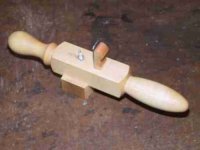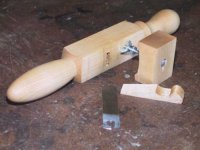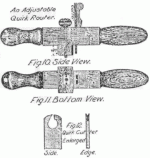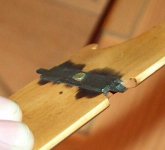Kent, et al:
The only source I'm aware of regarding the handrailers' quirk router is George Ellis' _Modern Practical Stairbuilding and Handrailing_. In a chapter entitled, "Apparatus and Tools Used in Stair Construction and Handrailing," he illustrates an adjustable quirk router of which he writes:
*****************
"The Adjustable Quirk Router (Figs. 10 and 11 [see attachment] ...) is, in its specialised form, a home-made tool. There are varieties, both in wood and iron, to be met with in the tool shops, but the former are intended for ordinary woodworkers' use, and do not exactly meet handrailers' requirements, whilst the latter, though stronger than wood, do not, at least in the author's opinion, work so sweetly as the home-made article.
The form shown is somewhat elaborate; many workmen are satisfied with simply a square stick with the rough edges filed off and a wood screw driven through the fence. Certainly a good workman will accomplish wonders with makeshift tools, but, other things being equal, the better the tool the better the work, and the author always had a penchant for making his own tools, so he offers his own design for those who care to follow it. The quirk cutter, which is a piece of [hardened and] tempered steel about 3 ins. long and 3/4 in. wide, of various thicknesses, is shown in the two views, Fig. 12. The ordinary shop-made article is always flat or straight across the face, but cutters work much easier if slightly curved in section, which can be done by softening the cutter in a gas jet, then bending it in a steel vice between two hardwood blocks to the required curvature, afterwards re-tempering it - a little job that any blacksmith will do. The author did his own, but the description of the process would be rather lengthy. The stock is 1 1/2 in. square, about 12 ins. long, with small handles turned at the ends; the cutter fits tightly in the mortise, which must be quite upright and is wedged as shown. The sliding fence, lips over the stock, is reversible; one side is rounded slightly, the other straight. It is fixed in any desired position with a thumb-screw. An ordinary "plough-stop" screw answers the purpose. A small slotted plate is sunk in the top side, in which the screw works; the amount of adjustment is about an inch, as shown by the dotted lines. The underside of the stock should be slightly rounded, because the tool must have a rocking motion when worked, because the V part of the cutter, which is in advance of the chisel edge, has to be scored-in before the cut is made. "
********************
It will be seen that I followed his design fairly closely - and I was not disappointed. I didn't put the slight relief curvature in the cross-section of the blade, and think it might be a good idea for deeper cuts. Though not essential, in my experience. For the cutter, I used a piece cut from an older non-carbide tipped circular saw blade, and it served quite well.
I'm tempted to add more details, but think it may be better to see what questions, if any, arise.
Don McConnell
Eureka Springs, AR




